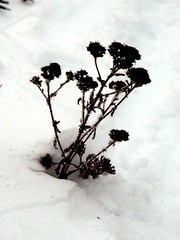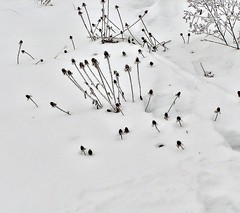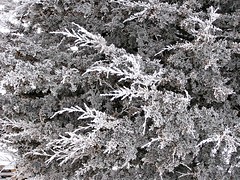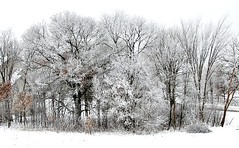January 19, 2010. Here in East Central Minnesota we've been experiencing the mid-January thaw, that amazingly regular spell when the temperatures pop up from bitter cold to near or slightly above freezing for a short time. Occasionally the warm air that moves in over the cold landscape causes a fog that not only hangs in the air but freezes in thin plates and crystals on the trees and bushes. They all become part of a frosted fairyland. The frosting can be bad for the trees but it gives us a show as good as a midwinter fireworks display. This morning the skies were solid gray. A quick look out the window showed that the freezing fog had been at work during the night. The familiar world had been transformed into one of white, gray, and black.
The light was flat, which can be pretty good for photography in the snow. In mid-afternoon I shoved my little Olympus camera into a warm pocket, put on my cross-country skis and headed out for a tour of the two acre prairie we are restoring year by year. Part of the beauty of a prairie landscape carries through the winter when the unique stems and flower heads of summer poke out of the snow adding an interesting texture to the landscape.
The first character I met going down the hill on the east end of the house was this sky blue aster. About now it's probably blue with the cold, but early in the fall it, and its like-flowered associates, regaled us with clouds of blue flowers. It seems to have produced a good crop of seeds so we'll be looking for more of the odd almost black stems of this plant in midsummer.
A few feet further on stems and seed heads of yarrow brought back memories of patches of white blooms that lasted a good part of the summer. Yarrow is a coarse plant, not one of my favorites, but it's a great starter-upper in a new prairie.
A good part of the hillside is covered by black-eyed susans. These were the most prolific plants in our one year old prairie last summer. Their bright yellow flowers came on in early summer and only faltered when the severe heat and drought of late summer spoiled their party. This is one of those plants that is so common that we don't pay much close attention to it, but we should. The seed heads looking like arrows poking skyward seem to indicate this plant still has lots of get up and grow.
The white cedar by the compost pile got it's share of frosting. This dense foliage is a haven for birds frost or no frost. I could hear a few dark-eyed juncos in the branches as I went by.
I couldn't help but take a close up of this interesting pattern of the frosty cedar branches.
Looking down toward the southwest corner of our lot I noted that the trio of box elder, white oak, and a sixty foot high black cherry made a nice grouping. The landscape arrangement is courtesy of mother nature.
To the south, behind the rise covered in staghorn sumac the leaves still clinging to the red oaks gave a touch of color to this otherwise white and frosty landscape.
The view along the line of trees running east, up the hill to our neighbors lot, made me think that some landscape painter had been working here but with only white paint.
The ice fog isn't a very common occurrence so I never take it for granted. The fragile frosting typically only lasts for a day or two and then becomes a memory. I never tire of looking at the almost surreal landscape it creates while it lasts.










1 comment:
What a beautiful photograph of this little plant surviving in the snow, showing off its little contours. I can see its relative size by the footprint beside it. So glad you can venture out on a day like that to see what snowy treasures await discovery.
Post a Comment